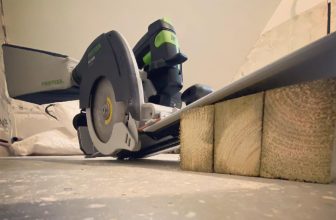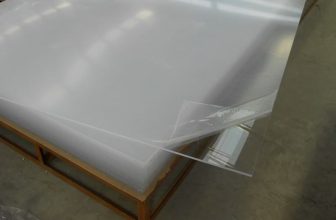Can You Cut PVC With a Circular Saw and Do You Know How to Do It Right?
Most of the plastics used in advertising and interior design are quite easy to machine, even at home or in small workshops. However, working with each variety requires a special approach. Plastic surfaces are prone to scratches and the edges sometimes need to be polished when a project is completed. Consider whether you can cut PVC with a circular saw, how you can cut monolithic polycarbonate and the better to cut acrylic. It is these materials that are most often used in advertising and design projects.
Contents
What Kind of Circular Saw Blade Do I Need to Cut PVC?
When choosing how to cut PVC pipe with a circular saw or how to cut polycarbonate at home, some prefer a circular saw, and this method requires more concentration compared to electric saws. To achieve the best result, it is advisable to use a saw with uniform teeth, plus there is a limitation on the width of the parts. This method is time consuming and will require extensive polishing of the ends to bring back the clarity and brilliance of the acrylic.
A circular saw to cut PVC is also suitable for straight cuts. The guard and face gauge make it easier to control and increase the accuracy of the work. The power of even an inexpensive saw is more than enough for plastic. If you can’t find a dedicated saw, any cutting PVC blade with fine teeth (i.e. more teeth) should also work. Typical woodworking blades simply break and damage the plastic, making them unsuitable. Apply masking tape along the cutting line to soften the chips. It must be remembered that moving too fast will melt and weld the freshly cut acrylic or other plastics, making it a solid piece. It can rightly be called the best saw for cutting PVC pipe.
Step by Step Guide on How to Cut PVC With a Circular Saw
When wondering whether you can cut PVC with a circular saw, there are several important parameters to consider. The circular saw does the job perfectly:
- When working with it, you should not make great efforts in the form of “pressure” to speed up the process.
- It is necessary to cut the material only at low speeds.
- Before starting work, the panel must be brought into a warm room for a couple of hours. This will prevent cracking and breaking of the material during the cutting process.
- So that the cut is not noticeable, the panel is always sawn with the wrong side down.
- When cutting several panels at the same time, they must be fixed on both sides with clamps or a press.
- When working with power tools, it is recommended to protect your eyes with special goggles and add at least parts of other safety clothing to your costume.
By following these simple rules, you can easily cut PVC with a circular saw.
How to cut PVC pipe lengthwise with circular saw
Pipes are the most common type of plastic rolled products. The process of cutting HDPE type polyethylene pipes is not such a simple operation as it might seem at first glance. After all, low-pressure polyethylene pipes have very thick walls, and the structural material itself, although it can be machined, is also characterized by high elasticity.
The pipe cutting process is as follows:
- a clearly visible mark is placed on the surface of the pipe, marking the place of the cut with it;
- the base is placed over this mark, controlling its position through the slot of the base;
- then, applying force, they cut into the pipe and, gradually increasing the force, make the final cut of the pipe.
The advantages of scissors are rather high efficiency and low cost of construction. The disadvantage is considered a direct connection between the effectiveness of the tool and the physical strength of the person working with it. In addition, during the cut, it is necessary to monitor the smooth movement of the brush, otherwise the blade may simply slip off the gear rack.
The circular saw blade for PVC is driven exactly along the edge of the masking tape without deviating to the side. This will allow you to cut the required length evenly.
Evening the Edges of the Pipe After the Cutting Is Done
Facing is a term used to refer to the operation of creating a narrow chamfer, consisting of forming a flat surface at the end of a pipe. Proper turning of the end facilitates the linear laying of pipes before welding and contributes to the formation of a gap of a constant size between the edges to be welded. These two parameters are of particular importance to maintain the correct weld pool and to ensure that the root pass fully penetrates the weld.
Pipe manufacturing tolerances can lead to varying thicknesses around the circumference of the pipe. This, in turn, can lead to a varying thickness of the edge face during the chamfering operation. This is usually the basis for recommending an internal boring operation for welding.
This operation consists of lightly machining the inner surface of the pipe in order to provide a constant width of narrow bevel or blunt edge along the entire circumference of the pipe. The presence of a narrow chamfer of the same width facilitates the implementation of the root pass. This is of particular importance in an automated welding process, since the device used cannot evaluate and compensate for possible deviations of a narrow bevel, which do not occur with manual welding.
Other Tools That Can Cut PVC
The following equipment is recommended for cutting:
- A hacksaw for wood – it is not recommended to take it with a very large tooth, otherwise the edge will turn out to be loose, in addition, the teeth can hook and pull the decorative film along with them.
- Hacksaw – cuts accurately and carefully but slowly, so it can be used for isolated cases when you need to adjust something.
- Grinder with a cutting wheel – cuts quickly and accurately, but a lot of dust is generated, therefore it is suitable for working on the street, or during a major overhaul.
- Electric jigsaw – suitable for indoor use, since it is possible to connect a vacuum cleaner to it.
These are other tools to cut PVC pipe high quality and smooth. The blade is pressed against the material with force, after which an incision is made sharply and the fragment is broken off with the hands, while cutting the film from the opposite side with a knife; metal scissors can be used in the same way.
FAQ
Can PVC be cut with a blade on wood?
Yes, you can cut it. To do this, you need to firmly fix the PVC on the table, determine an even cut, put on protective equipment and cut.
Why do you need to straighten the edges of the pipe after cutting it?
After trimming, small burrs and microcracks are formed that require smoothing.
Can PVC be cut with a circular saw?
Yes, you can cut a PVC with a circular saw. But unlike other cutting methods, it is necessary to prevent the plastic from melting (pause in time or cool it with water).
How to clean PVC from a circular saw
Cleaning and preparation of the cut material is carried out by means of polishing and cleaning materials.
A Few Words as a Conclusion
We hope that the information provided in the article above was able to help you understand this issue. What do you think about this? Do you have any tips or tricks to make this process easier? Share your opinion in the comments!
“A good tool stays with you for many years and choosing carefully ensures the job is done right, your work is neat, and the tool is always a pleasure to use”






